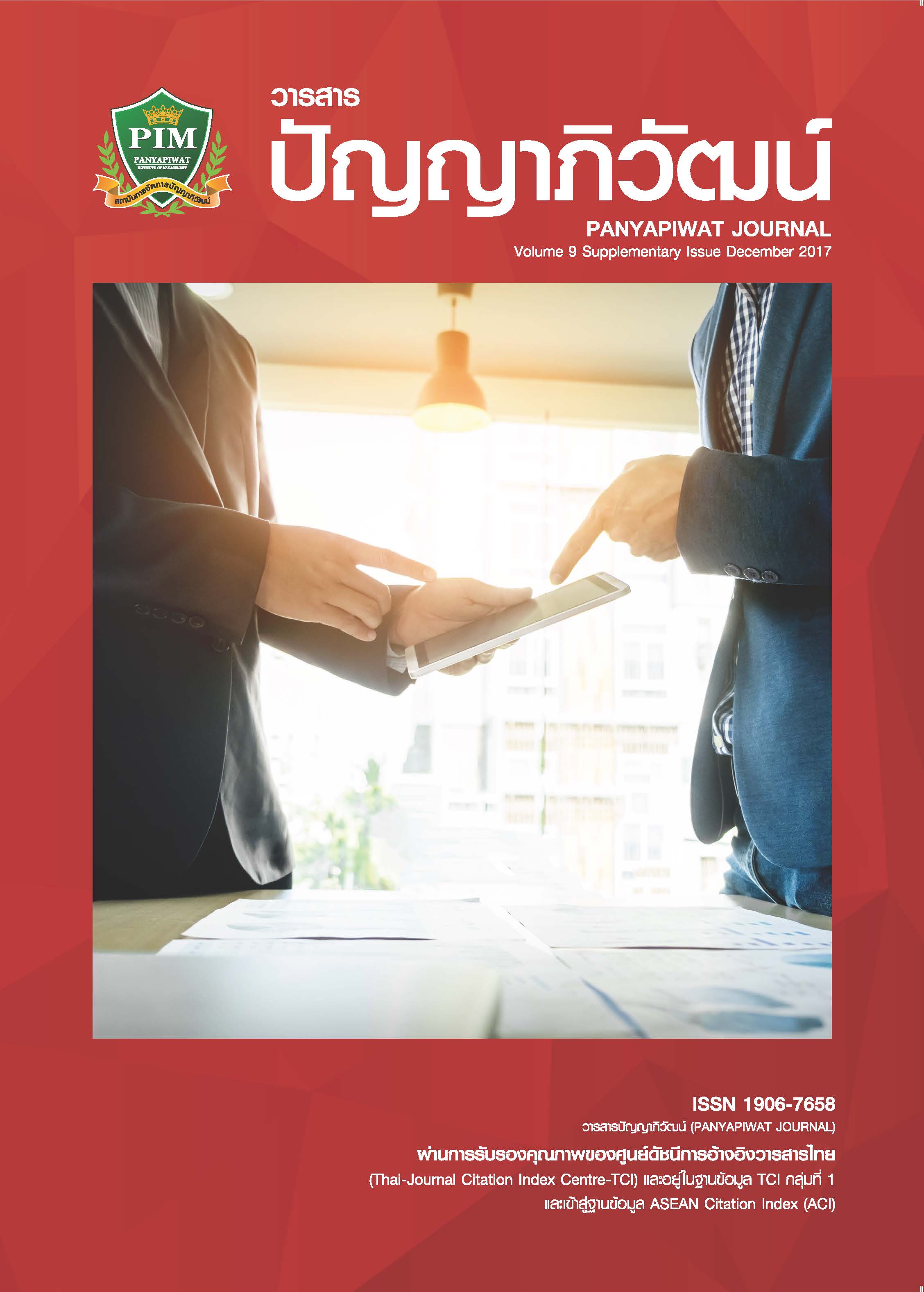VEHICLE ROUTING FOR BLOOD PRODUCT DELIVERY
Main Article Content
บทคัดย่อ
This study examines a real life case from a third-party logistics service provider using vehicles to substitute for hospital ambulances. The vehicle routes of blood product delivery are designed with the primary goal to minimize travel time from the National Blood Center (NBC) to hospitals. Each vehicle starts from the NBC and performs a tour on a designed route. Hospitals in the service system are located in the Bangkok metropolitan area, and also in other provinces having an airport nearby. For the latter group, the delivery is dropped off at Don Mueang International Airport and shipped to a destination airport. Integer programming is employed and coded in IBM ILOG CPLEX. Units of blood products are relatively small, compared to the capacity of vehicles. Thus, a change in hospital demand does not affect a route. Sensitivity analysis is studied only on the length of stay. A solution methodology is tested on real data obtained from past activities. The result recommends a maximum time for length of stay at a hospital in order to obtain an optimal solution. A time reduction from the maximum length of stay does not affect the delivery pattern.
บทความนี้นำเสนอการออกแบบเส้นทางจัดส่งเลือดและผลิตภัณฑ์เลือด โดยมีวัตถุประสงค์หลักเพื่อใช้เวลาในการจัดส่งให้น้อยที่สุด การจัดส่งจากศูนย์บริการโลหิตแห่งชาติไปยังโรงพยาบาลต่างๆ ให้บริการโดยบริษัทขนส่ง 3PL เอกชนที่นำพาหนะมาทดแทนรถฉุกเฉินของโรงพยาบาล โรงพยาบาลที่เป็นลูกค้าอยู่ในกรุงเทพและปริมณฑล หรือเป็นโรงพยาบาลในต่างจังหวัดที่อยู่ใกล้สนามบิน ซึ่งเลือดและผลิตภัณฑ์เลือดสำหรับโรงพยาบาลในกลุ่มสุดท้ายนี้จะนำส่งที่สนามบินนานาชาติดอนเมืองเพื่อนำส่งไปยังสนามบินปลายทางการศึกษานี้ใช้แบบจำลอง integer programming และโปรแกรม IBM ILOG CPLEX เพื่อหาคำตอบเส้นทางนำส่ง ขนาดบรรจุของผลิตภัณฑ์เลือดมีขนาดเล็กมากเมื่อเทียบกับขนาดของรถที่ใช้เพื่อการขนส่ง ทำให้เมื่อมีการเปลี่ยนแปลงความต้องการเลือดจะไม่ส่งผลกระทบต่อการเส้นทางจัดส่งที่ออกแบบไว้ ดังนั้นการวิเคราะห์ความอ่อนไหว (sensitivity analysis) จึงไม่รวมการเปลี่ยนแปลงความต้องการผลิตภัณฑ์เลือดและศึกษาเฉพาะผลกระทบของเวลาที่รถขนส่งจอดเพื่อให้บริการ ณ โรงพยาบาล (length of stay) แบบจำลองนี้ได้ทดสอบกับข้อมูลจริงจากบริษัท 3PL ที่ให้บริการอยู่ในปัจจุบัน ผลการศึกษาแนะนำค่าระยะเวลา length of stay ในการให้บริการและการลดเวลานี้ไม่มีผลกระทบต่อเส้นทางการจัดส่ง
Article Details
“ข้าพเจ้าและผู้เขียนร่วม (ถ้ามี) ขอรับรองว่า บทความที่เสนอมานี้ยังไม่เคยได้รับการตีพิมพ์และไม่ได้อยู่ระหว่างกระบวนการพิจารณาลงตีพิมพ์ในวารสารหรือแหล่งเผยแพร่อื่นใด ข้าพเจ้าและผู้เขียนร่วมยอมรับหลักเกณฑ์การพิจารณาต้นฉบับ ทั้งยินยอมให้กองบรรณาธิการมีสิทธิ์พิจารณาและตรวจแก้ต้นฉบับได้ตามที่เห็นสมควร พร้อมนี้ขอมอบลิขสิทธิ์บทความที่ได้รับการตีพิมพ์ให้แก่สถาบันการจัดการปัญญาภิวัฒน์หากมีการฟ้องร้องเรื่องการละเมิดลิขสิทธิ์เกี่ยวกับภาพ กราฟ ข้อความส่วนใดส่วนหนึ่งและ/หรือข้อคิดเห็นที่ปรากฏในบทความข้าพเจ้าและผู้เขียนร่วมยินยอมรับผิดชอบแต่เพียงฝ่ายเดียว”
References
Beliën, J. & Forcé, H. (2012). Supply chain management of blood products: A literature review. European Journal of Operational Research, 217(1), 1-16.
Bodhipundit, P. & Pathomsiri, S. (2011). Distribution of blood in Thailand: modes and associated cost. Proceeding of IE Network Conference, 20-21 October 2011. Pattaya, Chonburi. 1554-1559. [in Thai]
Braekers, K., Ramaekers, K. & Nieuwenhuyse, I. V. (2016). The vehicle routing problem: state of the art classification and review. Computer & Industrial Engineering, 99, 300-313.
Caric, T. & Gold, H. (2008). Vehicle Routing Problem. Croatia.
Chandran, B. & Raghavan, S. (2008). Modeling and solving the capacitated vehicle routing problem on trees. In Golden B., Raghavan S., Wasil E. (eds). The Vehicle Routing Problem: Latest Advances and New Challenges. Operations Research/Computer Science Interfaces, vol 43. 239-261, Springer, Boston, MA.
De Jaegere, N., Defraeye, M. & Van Nieuwenhuyse, I. (2015). The vehicle routing problem: State of the art classification and review, KU Leuven. Faculty of Economics and Business, 1-30.
Eksioglu, B., Vural, A. V. & Reisman, A. (2009). The vehicle routing problem: A taxonomic review. Computer & Industrial Engineering, 57, 1472-1483.
Gunpinar, S. & Centeno, G. (2015). Stochastic integer programming models for reducing wastages and shortages of blood products at hospitals. Computers & Operations Research, 54, 129-141.
Hardwick, J. (2008a). Blood processing. ISBT Science Series, 3, 148-176.
Hardwick, J. (2008b). Blood storage and transportation. ISBT Science Series, 3, 177-196.
Health Sciences Authority of Singapore Government. (2016). Blood Components and their uses. Retrieved May 8, 2017, from www.hsa.gov.sg/content/hsa/en/Blood_Services/Blood_Donation/Why_Should_I_Donate/Blood_Components_and_Their_Uses.html
Kumar, S. N. & Panneerselvam, R. (2012). A Survey on the Vehicle Routing Problem and Its Variants. Science Research, (4), 66-74.
Ozener, O. O. & Ekici, A. (2011). Vehicle Routing for Blood Collection. Proceeding of the 2011 Industrial Engineering Research Conference. Institute for Industrial Engineers Annual Conference and Expo, May 21-25, Reno, NV.
Pathomsiri, S. & Sukaboon P. (2013). Determination of a fair price for blood transportation by applying the vehicle routing problem: A case for National Blood Center, Thailand. International Journal of Social, Behavioral, Educational, Economic, Business and Industrial Engineering, 7(2), 452-457.
Rabbani, M., Aghabegloo, M. & Farrokhi-Asl, H. (2016). Solving a bi-objective mathematical programming model for bloodmobiles location routing problem. International Journal of Industrial Engineering Computations,8(1), 19-32.
Şahinazan, F. G., Kara, B. Y. & Taner, M. R. (2015). Selective vehicle routing for a mobile blood donation system. European Journal of Operational Research, 245, 22-34.
Sukaboon, P. & Pathomsiri S. (2011). Routing of blood distribution in Bangkok metropolitan region: A case study for the National Blood Center, Thai Red Cross Society. Proceeding of IE Network Conference, 20-21 October 2011. Pattaya, Chonburi. 1543-1547. [in Thai]
The Rider’s Digest. (2013). Blood Runner 182. Retrieved May 8, 2017, from www.theridersdigest.co.uk/blood-runner-2/
Yi, J. & Scheller-Wolf, A. (2003). Vehicle routing with time windows and time-dependent rewards: A problem from the American Red Cross. Manufacturing & Service Operations Management,5(1), 74-77.

